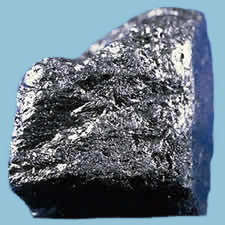Home | Glossary | Resources | Help | Contact Us | Course Map
Archival Notice
This is an archive page that is no longer being updated. It may contain outdated information and links may no longer function as originally intended.
Die Extrusion
Processing the plasticized nitrocellulose mass combines extrusion with rotating cutters to produce the desired shape. Cutters rotate in a plane flush with the exit nozzle of the extrusion die. By varying the size of the extrusion holes, the rate of extrusion, and the speed of the cutter rotation, the manufacturer can produce cylindrical or disk/flake shapes.
A slow extrusion rate combined with a high cutter rotation speed produces disk/flake propellants. A fast extrusion rate with a slow cutter speed produces cylinders.
Extruding sticky pieces of nitrocellulose into air would result in another mass of nitrocellulose. To avoid this, the extrusion nozzle and cutter assembly are submerged in a tank filled with a liquid that will not degrade the material. This floats cut pieces away from the cutter without their sticking together.
See the YouTube Terms of Service and Google Privacy Policy
Making Ball Propellants
Instead of falling into a tank after extrusion, the granules move immediately into a liquid-filled shaper that keeps the granules in constant motion. The action of granule against granule and against the walls and paddles of the shaper unit beats the cut granules into spheroids. The action is much like that of placing a cube of modeling clay into a large can, closing the lid, and shaking it. The clay cube will be rounded. The liquid in the shaper contains chemicals that start to draw off excess moisture from the granules. From the shaper, the granules move to a series of progressive evaporators that drive off unneeded solvents.
Although most finished ball powders are double-base, they start as pure nitrocellulose. In ball powder production, the nitroglycerin is added after shaping. The NG content is created by surface impregnation. The impregnated granules are sorted by size, and any coatings required are added before drying. If the powder is to be flattened ball, the granules are roller pressed at this still-soft stage.
Drying
The newly cut propellant granules contain residual moisture. The granules must be dried to reduce the moisture content to the level required in the finished product. Each grade of propellant has a different moisture requirement. If the granules are too wet, they will stick together in the loading process; if too dry, the granules will be brittle and break into smaller particles. Such breakage increases surface area and therefore the burning rate; if pulverized, an otherwise safe charge of propellant will create high pressures.
High heat can drive off needed solvents in single-base propellants or make double-base propellants more brittle. Therefore, the wet granules are usually dried with large volumes of air blown into a rotating drum. Heat, if any, is kept very low.
During drying, antistatic coatings and other surface treatments are added. Antistatic coatings are typically composed of graphite, which gives the granules the grey color seen in a finished sample. The natural color of nitrocellulose is pale yellow to green-yellow.
Deterrent Coatings and Stabilizers
Deterrent coatings can help to slow the rate of energy release when needed. A propellant loaded in a low-velocity cartridge will carry minimal deterrent; a higher-velocity cartridge requires more deterrent to maintain firing pressure longer. A common strategy is to blend deterred and undeterred granules in the same propellant. This slows energy release through staged burning; the undeterred granules burn first.
Stabilizers are preservatives used to increase storage life. Common stabilizers are found in the diphenylamine family.
Additional Online Courses
- What Every First Responding Officer Should Know About DNA Evidence
- Collecting DNA Evidence at Property Crime Scenes
- DNA – A Prosecutor’s Practice Notebook
- Crime Scene and DNA Basics
- Laboratory Safety Programs
- DNA Amplification
- Population Genetics and Statistics
- Non-STR DNA Markers: SNPs, Y-STRs, LCN and mtDNA
- Firearms Examiner Training
- Forensic DNA Education for Law Enforcement Decisionmakers
- What Every Investigator and Evidence Technician Should Know About DNA Evidence
- Principles of Forensic DNA for Officers of the Court
- Law 101: Legal Guide for the Forensic Expert
- Laboratory Orientation and Testing of Body Fluids and Tissues
- DNA Extraction and Quantitation
- STR Data Analysis and Interpretation
- Communication Skills, Report Writing, and Courtroom Testimony
- Español for Law Enforcement
- Amplified DNA Product Separation for Forensic Analysts


